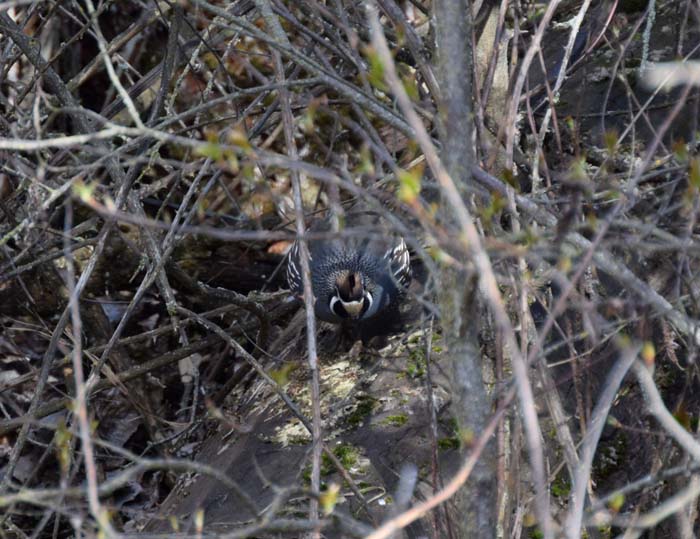Speaking valley quail
Published 8:00 am Saturday, April 18, 2020

- A male valley quail sneaks through the brush as Brad Trumbo “talks” with separate coveys.
PENDLETON — During these days of house arrest, I am lucky enough to telework in my basement “deer room,” yet maintaining sanity within the confines of my own property is largely left to sunny day chores like gardening and tending to our small orchard and food plot. Unfortunately, no matter how enjoyable the chores, when the turkeys are fired up and the walleye staging for spawn, there is much to be desired away from home, among our public resources.
Did I mention the valley quail are paired up? One of my homestead hobbies is enhancing habitat for upland birds. My local quail numbers range between 60 to 100 birds at any given time. The past few years, I have taken a greater interest in quail, having fallen in love with the scurrying little gray ghosts with the top knot that bobbles carelessly as they feed and run. Valley quail are a “gentleman’s” bird, meaning the coveys hold for the dog, they get up two or three flushes per covey, the singles are a hoot to pursue, and they are simply gorgeous. One of the most pleasant upland birds to hunt over a pointing dog.
I began reading up on quail behavior and studying their vocals and soon found myself immersed in a new learning opportunity. Given my science background and upland hunting obsession, and my present state of stir-crazy, the prospect of quail calling piqued my interest. It never before occurred to me that I could call quail, and for several reasons, including I had no clue that quail calls existed; I am a miserable failure at calling turkeys, which is an entirely different story of its own; and I run a decent brace of setters in the uplands.
Why would I need a bird call?
Being a connoisseur of handcrafted woodwork, I was easily drawn to a Jim Matthews Signature rubber band call. A beautifully crafted tool that allows me to interact with upland birds outside of hunting season was simply too tempting. When my call finally arrived, I rolled the handsome, walnut quail harmonica in my hands and admired the RST 12-gauge brass that Jim embedded for me. It provides a nice touch of bling. Just how in the hell to work the thing was another consideration altogether.
Rather than read up or watch YouTube “how-to” videos, I like to leave an element of mystery to be figured out on the fly with these sorts of endeavors. It’s not because I am stubborn or think I am too intelligent for a little instruction. Trust me, I read the manual when piecing some store-bought gadget together. Rather, I find it part of the adventure to figure things out on my own, particularly when the risk of catastrophic failure is low.
Skipping the tutorials, I stepped outside and rasped on the call. And, as expected, lessons were learned immediately.
There are two sides to the call — rounded and square. Both produce sound, but the rounded side is much louder and activates a “sound chamber.”
A little cheek pressure wasn’t going to cut it for these calls. I am talking full-diaphragm engagement to hit the right pitches and timing of the three-part “Chi-ca-go” call, which I will explain in a moment. The call was raspy like an old hen turkey. Like all animals, quail have unique voices, but I am certain every quail within earshot went silent as my caterwauling drifted across my property.
The beauty of the rubber band call is that its adjustable on the fly. Pulling an end tightens the band and changes the pitch and rasp instantly. You can actually imitate multiple birds. Having mastered this in a matter of moments, I belted out a few acceptable “Chi-ca-go” calls and called it good on disturbing the peace for an evening.
“Chi-ca-go” is the most identifiable call a valley quail makes and is used to “assemble” the covey. Anyone having experience with these birds can picture the male standing tall atop a fence post or tree branch, watching over the covey as they feed, and vocalizing the “Chi-ca-go” call. Also of note, this call was documented in literature as “cu-ca-cow” back in the early 1900s. I found it only recognized as “Chi-ca-go” in literature from around the 1970s and later. I am left to believe the phonics of “Chi-ca-go” more closely resemble the “syllable” enunciation of the call relative to human interpretation and description.
I typically carry my call when working around home because the quail are always about and calling, except midday when they loaf in the brush piles and blackberries. Recently, while building new brush piles, I took a seat on the hill overlooking the property and broke out the call. With the elegance of a pro, I cut lose a superb “Chi-ca-go” call and was answered almost immediately by a male down by the pond.
This time of year, as the quail break into pairs and sub-coveys, I like to whip out the call and sneak in between groups. Mimicking the number of calls in a sequence as those calling around me, I most always elicit a conversation. Taking a seat for a moment to enjoy the interaction, I usually spot a few quail poking their way through the brush, working in to my call. Additionally, when calling to a covey in plain sight, I have noted the senior male is the only bird that takes notice and returns the call. The remainder of the covey continues its business, uninterested. That is, unless I am too close. The call volume alone can blow the entire covey into the nearest thicket.
While calling quail is not quite like following that high-tailed setter in search of a covey held tight to a creek-bottom snarl, calling is delivering quite a social education. As fall approaches, I will to try my hand at locating coveys afield. Calling in a busted covey can be quite effective, so I hear. Regardless of a covey’s affinity to vocalize with strangers come hunting season, I travel in the good company of three Llewellin setters with a knack for working over the silent type.
In the meantime, I’ll continue to enjoy small talk and social distance with my covey at home.




